One of the common challenges facing Chemistry students is writing chemical equations correctly. You cannot write chemical equations without first knowing the individual elements that make up the compounds.
Besides the individual elements of the periodic table, you should know the valency, oxidation states, and charge of the elements. If you have these settled, then, you can begin to learn the step-by-step guide on how to write chemical equations for any type of equation.
What are chemical equations?
Chemical equations are made of chemical formulas – reactants and products. The chemical formulas that make up these equations show the elements that make up the compound and the number of atoms of each element in the molecule or compound.
Furthermore, chemical equations are made of symbols, chemical formulas, and numbers that illustrate chemical reactions. As mentioned earlier, chemical equations contain reactants and products, the reactants on the left hand and the products on the right hand.
Additionally, chemical equations show the direction of the reaction and the process that occurs. Chemical equations use different symbols to show the presence of a catalyst, heat, or equilibrium in a reaction process.
Rules for writing chemical equations
- Identify elements by their chemical symbols. E.g Na for sodium, H for hydrogen, Cl for chlorine, Pb for lead
- The charge of ions depends on their position on the periodic table
- In ionic compounds, the sum of charges on all ions must be equal to zero
- The number of atoms of each element or ion is written by the bottom right of the symbol in subscript
- Each ion of compounds with polyatomic ions must be enclosed in a bracket with the subscript at the bottom right of the closing bracket. If the compound has only one polyatomic ion, the bracket would not be necessary
- When writing ionic compounds in equations, write the chemical formula for the cation (metal) before the chemical formula for the anion (nonmetal)
- When you write chemical equations, indicate the state of each molecule or compound at the bottom right of the molecule or compound in subscripts. Molecules or compounds should be in solid (s), liquid (l), gas (g), or aqueous (aq)
- Use the prefix mono- to deca- for 1-10 when writing chemical equations for covalent compounds as a guide to know the number of atoms of an element or molecule in the compound. E.g dibromide – Br2, dioxide – O2, tetraoxosulphate – SO4
- Also, remember that reactants should be on the left and products on the right of the arrow
- → shows that the forward reaction is favored, ← shows that the reverse reaction is favored, and ⇋ or ↔ for an equilibrium reaction
A step-by-step guide on how to write chemical equations
Example: potassium dichromate reacts with sulphuric acid to yield potassium sulfate, chromium sulfate, water, and oxygen
- Start with writing out the chemical formula for each compound
Potassium dichromate – K2Cr2O7, sulphuric acid – H2SO4, potassium sulfate – K2SO4, chromium sulphate – Cr2(SO4)3, water – H2O, oxygen – O2
- Then, write out the reactants and products with the arrow
K2Cr2O7 + H2SO4 → K2SO4 + Cr2(SO4)3 + H2O + O2
- Afterward, proceed to count and balance the number of atoms of each element on the reactant and product side. Balance all the atoms on both sides
2K2Cr2O7 + 8H2SO4 → 2K2SO4 + 2Cr2(SO4)3 + 8H2O + 3O2
- Finally, indicate the state of each compound with the respective symbol
2K2Cr2O7 (s) + 8H2SO4 (l) → 2K2SO4 (s) + 2Cr2(SO4)3 (s) + 8H2O (l) + 3O2 (g)
How to write net ionic equations
Writing ionic chemical equations begins with the overall chemical equation without the charge. The net ionic equation is a product of removing the spectator ions from the complete ionic equation.
Spectator ions are ions that appear on both sides (reactants and products) of the equation with the same coefficient.
- For example,
HCl(aq) + NaOH(aq) ⟶ NaCl(aq) + H2O (l)
- Afterward, separate the soluble ionic compounds into their dissociating ions
H+(aq) + Cl–(aq) + Na+(aq) + OH–(aq) ⟶ Na+(aq) + Cl–(aq) + H2O (l)
Note: water is not an ionic compound. Therefore, it won’t dissociate into ions
- Cancel out spectator ions. Here’s the equation:
H+(aq) + OH-(aq) ⟶ H2O(l)
You should keep in mind that you can only write ionic chemical equations correctly if you are familiar with the solubility of the ions. This will help you determine which ones are soluble in water.
FAQs
Is the chemical formula of a compound the same as the molecular formula?
Yes, it is. A molecular formula is a chemical formula but not all chemical formulas are molecular formulas. The molecular formula tells you the number of each type of atom in a molecule.
Is the chemical formula of a compound the same as the empirical formula?
All empirical formulas are chemical formulas, not all chemical formulas are empirical formulas.
Empirical formulas are the simplest chemical formulas. They show the most reduced ratio of elements in a compound. All chemical formulas show how many atoms of an element are in a compound.
Should the formula for all acids start with hydrogen?
Yes. The Arrhenius theory defines acids as compounds that contain more than one hydrogen atom and release hydrogen ions into solutions. Because of this, the chemical formulas are written with the “H” first.
Conclusion
Chemical equations fall under ionic or covalent. In ionic equations, the formulas are written as individual ions. On the other hand, covalent compounds contain nonmetals and are not written as ions because there is no electron loss or gain.
All chemical equations are written with the valency and charge in consideration. If you know the type of compounds in the reaction, it will take you little to no time to write down chemical equations.
Thanks for reading.
Visit Gezro to learn about chemical equations and general Chemistry.
